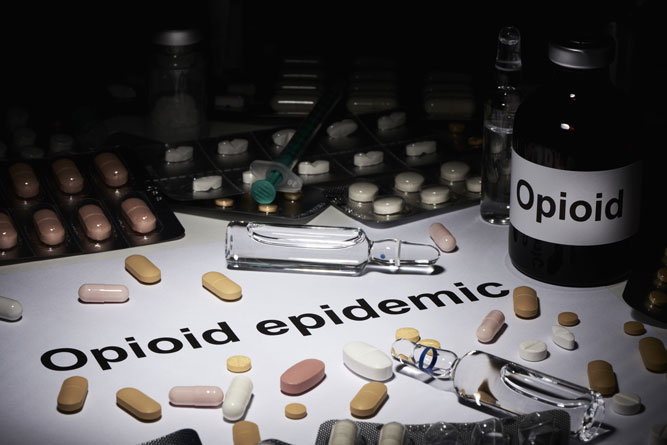The entire nation is facing a brutal opioid epidemic, but some states have been hit harder than others. West Virginia is currently the capital of opioid abuse in deaths per capita but Ohio is a close second. The Trump Administration is working directly with government departments and governors to help the states turn the corner from opioid abuse and death. The fight comes from a combination of funds and new programs and many of those new funds have gone straight to the Buckeye State.
Let’s learn what type of federal money is coming to Ohio, what it’s being directed towards, and other concrete steps to combat the opioid crisis. We’ll hear the thoughts of Ohio politicians on the epidemic and explore if the programs and funds are making an impact.
Federal Aid to Ohio
The biggest aid packages to the Buckeye State have come in the form of several federal grants. In fall of 2018, the Department of Health and Human Services (HHS) announced it would be sending Ohio a total of $71.5 million over two years to help fund new programs and expand services.
The $71.5 million is not for a random assembly of actions or programs. All federal grant money has been assigned to concrete steps and actions to battle the opioid crisis in Ohio. Of the $71.5 million, $55 million will be devoted to helping prescriptions and access to three FDA- approved drugs that have proven to aid opioid abuse. The remaining $16 million dollars has been earmarked for community health centers and other medical and psychiatric facilities to help promote awareness of opioids’ dangers, expand treatment programs, and increase funding to mental health services.
Where is the Federal Money Coming From?
Congress and the Trump Administration have started several programs to help combat opioid abuse not just in Ohio but across the country. The fight started with the declaration of the opioid crisis as a public health emergency, followed by the passage of the 21st Century Cures Act. Funding from the 21st Century Cures Act allowed the HHS to create the State Targeted Opioid Response (STOR) program.
The 21st Century Cares Act is legislation designed to expand several types of medical services and make federal funding more available where necessary. Part of the 21st Century Act’s funding includes $1 billion to be directed to opioid abuse prevention and treatment of opioid addiction. The $1 billion helped create the HHS’s STOR program which directs funding and resources directly to US states and territories as they require it. The $71.5 aid package mentioned above was a direct result of STOR.
More recently, the US Senate passed a new package of legislation to further help combat the opioid crisis. Ohio Senator Rob Portman (R) helped author the bill. The bill’s provisions include authorizing new grants to drug treatment programs, promoting research and development of non-opioid painkillers, and putting the mail system under the magnifying glass to help catch opioids delivered illegally by mail.
“The opioid crisis has continued to tighten its grip around communities across our country, and the emergence of fentanyl has presented a new challenge in turning the tide of this epidemic,” Portman said. “Just as we were making progress this more deadly, less expensive scourge has come in to our families, our communities, and our states. That’s why we need to take action.”
Other Opioid Abuse Programs in Ohio
The federal government has done a lot to help Ohio, but the Buckeye State is also working to heal itself. Recently State Representative Jim Butler (R) of District 41 introduced a series of bills he called a comprehensive opioid reform. The different parts of the bill are aimed at stemming opioid abuse and death by creating more treatment facilities, upgrading existing facilities, new criminal justice reform measures to help reduce the number of opioid addicts cycling in and out of jail, and creating better outreach programs.
Butler believes Ohio isn’t tasked with just battling opioid abuse, but addiction altogether. Butler agrees the simple ‘War on Drugs’ approach didn’t work in the past and likely won’t work against opioids. “It’s always going to be something, which demands a change in how addiction is approached by law enforcement and other officials, said Butler.”
Is it Working?
Unfortunately, you can’t just throw money at a problem and expect it to go away or we would have solved the opioid crisis years before. So – are these funds and programs doing anything to make a difference? Though many of these programs are in their infancy the early results are yes – the funds and programs are making a positive impact.
The Ohio Department of Health (ODH) reported a 23% decline in opioid-related deaths in the second half of 2017 and a 7% decline in prescription opioid-related deaths during 2016-2017. “The good news is Ohio is seeing significant progress in reducing the number of prescription opioids available for abuse, and as a result, prescription opioid-related overdose deaths that don’t also involve fentanyl are at their lowest level since 2009,” Ohio Department of Mental Health and Addiction Services Director Mark Hurst, M.D. said.
Millions of dollars and thousands of man-hours are being thrown at the opioid epidemic, and the early results show a positive trend. The opioid crisis has affected nearly everyone in Ohio, but help is continually coming. With the help of federal dollars, state dollars, and local programs, Ohio is quickly becoming a model in battling the opioid crisis.
Getting Help
Opioid addiction never ends well. The two most common final destinations for untreated addiction are prison and in the cemetery. If you or someone you love is addicted to opioids, you must reach out before the inevitable happens.
Our addiction treatment facility attacks the addiction in a safe and comfortable environment. We offer both help the user flush heroin from their body in a safe way and teach them the best ways to remain heroin free. To get this treatment started it only takes one phone call.







